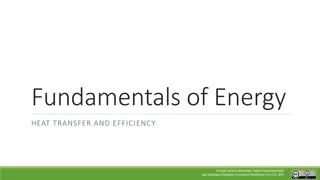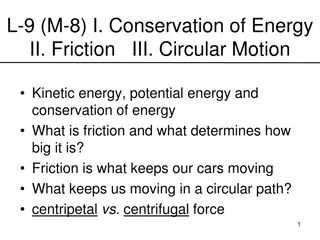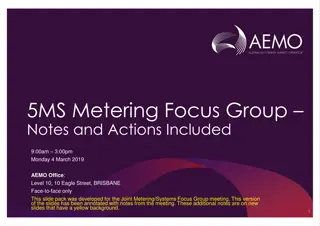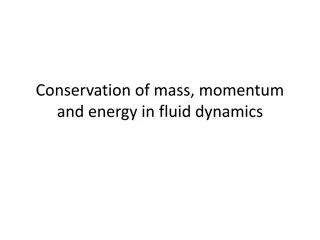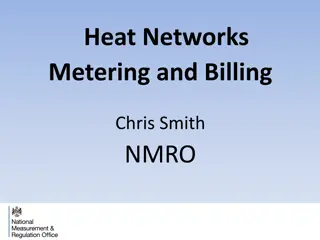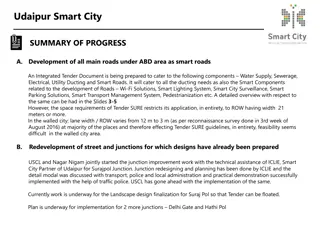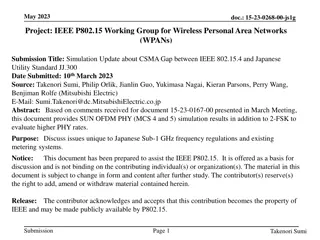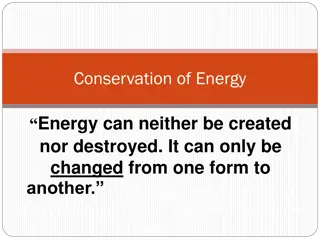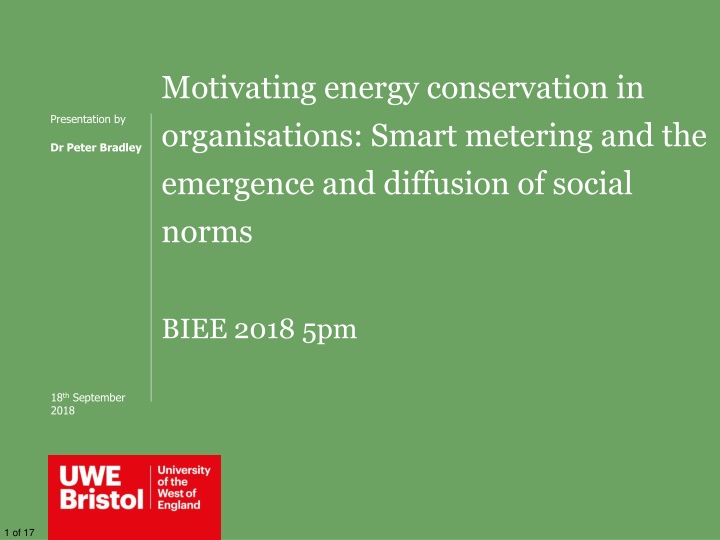
Motivating Energy Conservation in Organizations: Smart Metering and Social Norms
This presentation by Dr. Peter Bradley discusses the importance of social norms in energy reduction within organizations, focusing on the emergence, diffusion, and transformation of norms. The intervention of smart metering is explored to observe how social norms influence energy behaviors, with a case study highlighting the impact on behavior change. Various factors influencing social norms and their translation into behaviors are examined, providing insights into effective strategies for promoting energy conservation.
Download Presentation

Please find below an Image/Link to download the presentation.
The content on the website is provided AS IS for your information and personal use only. It may not be sold, licensed, or shared on other websites without obtaining consent from the author. If you encounter any issues during the download, it is possible that the publisher has removed the file from their server.
You are allowed to download the files provided on this website for personal or commercial use, subject to the condition that they are used lawfully. All files are the property of their respective owners.
The content on the website is provided AS IS for your information and personal use only. It may not be sold, licensed, or shared on other websites without obtaining consent from the author.
E N D
Presentation Transcript
Motivating energy conservation in organisations: Smart metering and the emergence and diffusion of social norms Presentation by Dr Peter Bradley BIEE 2018 5pm 18thSeptember 2018 1 of 17
What shall be covered What are social norms; Norm emergence, transformation and diffusion; Factors influencing social norms; Intervention of smart metering and study to observe the emergence and diffusion of social norms Results Conclusions 2 of 17
Social Norms and importance in energy reduction Provide social ques of appropriate behaviour depends on situation context specific; Two types of social norms; Descriptive and injunctive Why are they important? Signal appropriate action or behaviour in given situations. Important in bringing about (but sometimes create barriers to) changes in energy behaviours; The literature generally focuses on translation of social norms into behaviour but what about the pre-stage? Demand side response requires changes in energy behaviours - in some instances social norms can motivate changes in behaviours 3 of 17
Norm emergence; diffusion and translation Processes that lead to the development of social norms and behaviour: 1.) norm emergence 2.) norm diffusion and 3.) translation into behaviour. Norm diffusion involves the spread of social norms. The emergence process and the diffusion processes involve social construction (Lyndhurst 2009) and social comparison (Vishwanath 2006). Occur for both descriptive and injunctive norms and are informed from other referent individuals. Social construction is the theory that norms, beliefs and attitudes are constructed through a process of social interaction (Lyndhurst 2009). Goodman and Haisley (2007) identify that there are a number of ways to classify social comparison processes. They identify: initiation, selection of referents and an evaluation process as important. 4 of 17
Translation of descriptive norms into behaviour Components of the theory of normative social behaviour (Rimal and Real 2005) 5 of 17
Case study: social norms and smart metering in organisations Survey 2 (month after MEF launch) Interviews, after intervention Benchmark Smart metering installed Intervention (June, July, August, September) Data collection continuation (March, April, May) Survey 3 Survey 1 0 3 6 9 12 Month 6 of 17
Key survey questions Factor Questions I am very interested in what others think about the department When I talk about the department, I usually say 'we' rather than 'they' When someone praises the department, it feels like a personal compliment Answer Group identity 7 point likert scale from strongly disagree (1) to strongly agree (7) expectations By changing our behaviour, employees and students like me can reduce the department's energy use The department should do more to save energy I am concerned about the amount of energy that the department uses Outcome Energy conservation should not be a priority for the department now Descriptive How many people in your department: turn off office or lab equipment when they are finished using it? How many people in your department: turn off their computers before leaving work for the day? How many people in your department: turn off their monitors before leaving work for the day? How many people in your department: turn off the lights at their desk/office before leaving work? Five point scale: very few (1); 25%, 50%. 75%, Nearly everyone (5) norms If the other people in your department saw that a computer was left on when the user was not at work, they would: If the other people in your department saw that a monitor was left on when the user was not at work, they would: If the other people in your department saw that an individual's lights were left on when he/she was not at work, they would: If the other people in your department saw that office or lab equipment had been left on when it was not in use, they would: Five point scale: Stongly disapprove (1); disapprove somewhat; Neither approve nor disapprove; Approve somewhat; Strongly approve (5) Injunctive norms 7 of 17
Intervention energy feedback 8 of 17
Results social norm emergence Observations Index (mean) Standard deviation Minimum Maximum 31 2.5 31 3.2 31 2.5 31 4.1 31 2.9 31 2.5 31 2.9 31 2.5 Descriptive_norm_computers Descriptive_norm_office_or_lab_equipment Descriptive_norm_monitors Descriptive_norm_lights Injunctive_norm_computer Injunctive_norm_office_or_lab_equipment Inj_norm_monitor Inj_nrom_lights Descriptive statistics for descriptive and injunctive norms for energy services 1.03 1.04 1.31 1.22 0.67 0.96 0.65 0.93 1 1 1 1 1 1 1 1 4 5 5 5 4 5 4 5 Observations 17 17 17 17 17 17 17 17 Mean (Index) 2.3 2.4 2.8 3.1 3.1 2.9 2.6 2.8 Minimum 1 1 1 2 2 2 1 1 Maximum 4 5 5 5 4 4 4 4 Descriptive_norm_computer_(Benchmark) Descriptive_norm__monitor_(Benchmark) Descriptive_norm_computer_(Intervention) Descriptive_norm__monitor_(Intervention) Injunctive_norm__computer_(Benchmark) Injunctive_norm_monitor_(Benchmark) Injunctive_norm_computer_(Intervention) Injunctive_norm_monitor_(Intervention) Descriptive statistics comparison for the benchmark and intervention period 9 of 17
Results social norms emergence Significance Des_office_lab_(Int) - Des_office_lab_(Bench) Significance Des_computer_(Int) - Des_computer_(Bench) Significance Des_monitor_(Int) - Des_monitor_(Bench) Significance Des_lights_(Int) - Des_lights_(Bench) The median difference between the benchmark and intervention 0.688 0.048 0.04 0.417 Significance Inj_office_lab_(Int) - Inj_office_lab_(Bench) Significance Inj_computer_(Int) - Inj_computer_(Bench) Significance Inj_monitor_(Int) - Inj_monitor_(Bench) Significance Inj_lights_(Int) - Inj_lights_(Bench) The median difference between the benchmark and intervention 0.346 0.07 0.45 0.717 Related-Samples Wilcoxon Signed Ranks Test Significance of changes in injunctive and descriptive norms 10 of 17
Observed social norms and energy behaviour Des_norm_computers Energy efficiency ratio 0.00 0.10 0.20 0.30 0.4 Total Count 7 4 0 0 1 12 LOW Expected Count Std. Residual 3.4 2 4.8 -0.4 1 -1 1 -1 1.9 -0.7 12 Count Expected Count Std. Residual Count Expected Count 0 6 2 1 2 1 3 13 13 MODERATE TO HIGH 3.6 -1.9 7 7 5.2 0.4 10 10 2.1 0.6 4 4 0.9 2 2 0.9 2 2 Total 25 25 Cross tabulation of descriptive norms (computers) against energy efficiency Asymp. Sig. (2- sided) Exact Sig (2- sided) Exact Sig. (1- sided) Point Probability Value df a Pearson Chi-Square Likelihood Ratio Fisher's Exact Test 4 4 0.015 0.002 0.005 0.004 0.005 16.7 11.9 b Linear-by-Linear Association 1 0.009 0.005 0.002 0.000 No. of Valid Cases 9 cells (90%) have expected count less than 5. The minimum expected count is .96. The standardized statistic is 2.623. 25 Significance of the cross tabulations 11 of 17
Factors found to be most important in shaping social norms for study Social distance and interaction Proximity, location and referents The role of management, policy and culture in shaping social context Culture 12 of 17
Conclusions Environmental psychology good at pinpointing influence of social norms into behaviour, less good at looking at norm emergence; This study indicated that the intervention of smart meter implementation resulted in the emergence of energy consumption descriptive norms for some and these translated into energy behaviours; Some negative social aspects were also however observed from the study; It was found that much care is needed in designing and implementing smart metering as it can effect the types of social norms that emerge and motivations for reducing energy as well as peoples wellbeing 13 of 17
End For references and further reading see the full paper: Bradley, P., Fudge, S. and Leach, M. (2016) Motivating energy conservation in organisations: Smart metering and the emergence and diffusion of social norms. Technology Analysis & Strategic Management, 28, 4:435-461 14 of 17







